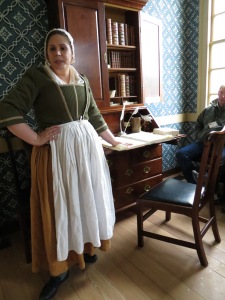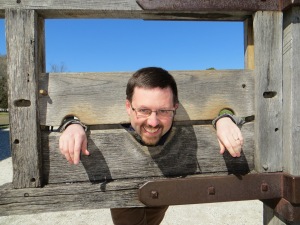The past months have given me several opportunities to travel into the Old Dominion State (sorry, that would be Virginia for those not up on state nicknames) and take in several of their historical sites with my family. I thought I’d offer some reflections on the various ways different sites presented their history.
Now, two some caveats. First, I should observe that I’m conflating my trips–although, come to to think of it–if you could manage a historical swing through Virginia that embraced both Revolutionary and Civil War sites you would have plenty to see.
Second, most of the visits were taken with small children in tow. On one hand, I really appreciated being able to expose my kiddos to historical sites and ideas. Seeing their eyes light up with fresh discoveries is terrific. I hope I’m planting some serious historical contexts into their lives. And, at the very least, my 6-year old can now report on the multiple uses of a bayoneted musket on an 18th-century battlefield. On the other hand, this meant I didn’t examine every detail as minutely as I might like. I tend to be a museum completionist, so these visits have altered how I look at things.
Over Spring Break we had the chance to do a three-day stint at Colonial Williamsburg. I was primed to be a bit skeptical, and let’s admit it–there is a faux-quality to trying to reproduce an entire 18th century town while hundreds of 21st century tourists mill around with smart phones. Still, I really enjoyed the experience. I give huge props to the historical interpreters who did great jobs staying in character yet translating for a modern audience who may know very little about Revolutionary Virginia. One woman we saw on successive days in different venues, and she did a fantastic job both times, relating to both children and adults.I enjoyed being able to toss early-America references into my interactions with some of the costumed participants, although I restrained myself from interrogating each of them on how they saw liberalism vs. republicanism motivating their desire for independence.
Exploring the town gave a great sense of scale. It only had about 2000 permanent residents at the Revolution–yet it was a key site for Virginia politics. A crowd gathering in front of the capitol or powder magazine could get to the governor’s mansion in a matter of minutes–time for passions to build but not to cool.
The strategy of Colonial Williamsburg might be labelled “living history,” and by doing it well I thought the program allowed an imaginative leap into the era of the American Revolution.
By contrast, the approach at Monticello might be termed a “great man/great house” presentation. Part of the presentation focused on the architectural beauty that is Monticello. Being there to soak in the Palladian structure carries definite weight. The presentation inside the house was quite respectful of “Mr. Jefferson,” which one would expect. Still, the guide was well-read on Jefferson’s world and so was able to contextualize the house’s contents and meanings when asked.
 Monticello has also expanded its treatment of slavery at Monticello and worked the Hemings family into the story. I appreciated the archaeological work that had been done to map out the slave outbuildings, which suggested that Monticello was a bustling concern with lots of inhabitants, not only a graceful structure serving a few whites.
Monticello has also expanded its treatment of slavery at Monticello and worked the Hemings family into the story. I appreciated the archaeological work that had been done to map out the slave outbuildings, which suggested that Monticello was a bustling concern with lots of inhabitants, not only a graceful structure serving a few whites.
Although Jefferson is not my favorite founder (to put it mildly), the site still impresses. I may still appreciate many of the Federalists critiques of Jefferson–o.k., I do. Even so, it was hard not to marvel a little at the level of learning and sophistication that Jefferson had brought to an area pretty close to the frontier. And yes, I would have wanted to be a part of one of Jefferson’s dinner parties when he was in his prime.
Finally, I had an afternoon to visit Yorktown Battlefield. I understand Yorktown has their own living history military encampment, but I skipped it to see the actual battlefield. Managed by the National Park Service, the presentation centered on artifacts and preserved battlefield. Many of the siege lines are still in place.
Here again, space mattered. Yorktown was only a village, and the siege area did not strike me as large. The redoubts which Alexander Hamilton assaulted were perhaps 30×30. By the time Americans got their second siege line up, the British were pinned down just a few football-fields away. The lesson again would be that significant events took place on a very limited scale.
Still, finding the historical heartbeat in the open green-spaces was more difficult. More could have been done with both information and context.
So, seeing three different styles of interpretation can prompt us to think about history can best be presented. I appreciated the semi-immersive sense of Colonial Williamsburg. I’d like to build into my students that sense of a world inhabited by people confronted with American Independence.
For commentators, let me ask–where are the places that history comes alive for you? And, why does it happen there? What are the historical sites you’ve most loved exploring?




